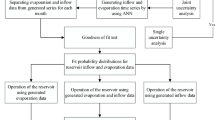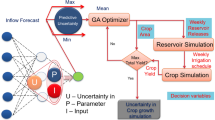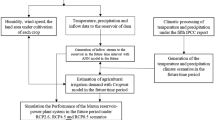Abstract
Water supply operation of a reservoir group is a critical strategy for mitigating conflicts between water resource supply and demand in a basin. However, the uncertainty of runoff forecast presents significant challenges to this operation. To explore the risk laws of the complex water supply process, this study focuses on analyzing the three primary source streams and the main stream of the Tarim River, the largest inland river in China. Initially, a runoff forecast model is developed utilizing Long Short-Term Memory Artificial Neural Networks (LSTM-ANN) to generate runoff datasets. Subsequently, a theoretically optimal operation process for the reservoir group is derived through a long-series deterministic multi-objective operation, which establishes boundary constraints for water supply risk operation. Finally, the runoff forecast results are integrated into an uncertainty water supply risk operation model to assess the associated water supply risk. The results indicate that: 1) Due to varying guarantee rates and water supply priorities among different sectors, the risk of ecological water supply is the highest, followed by agriculture and then domestic-production. 2) Within an effective forecast range of 0% to 20%, the most significant increase occurs when the error ranges between 5 to 10%. 3) As the reservoir regulation capacity in mountainous areas increases, the average water supply risk value for agriculture decreases from 0.086 to 0.040, representing a 53.1% risk reduction. The research results are of great significance to the reservoir group risk operation and the water supply safety in the basin.










Similar content being viewed by others
Data Availability
The dataset on which this paper is based is too large to be retained or publicly archived with available resources. Documentation and data used to support this study are available from hydrological station data.
References
Adams LE, Lund JR, Moyle PB et al (2017) Environmental hedging: a theory and method for reconciling reservoir operations for downstream ecology and water supply. Water Resour Res 53(9):7816–7831. https://doi.org/10.1002/2016wr020128
Bai T, Yu J, Jin W et al (2021) Study on risk analysis of Sanhekou Reservoir operation based on different water demand processes. J Hydroelectric Eng 40(8):12–22 (in Chinese)
Bai T, Yu J, Jin W et al (2023) Multi-objective and multi-scheme research on water and sediment regulation potential of reservoirs in the upper Yellow River. Int J Sedim Res 38(2):203–215. https://doi.org/10.1016/j.ijsrc.2022.10.004
Celeste AB, Cai X, Ponnambalam K et al (2020) New considerations for a reservoir capacity optimizer that accounts for failure risks. J Water Resour Plan Manag 146(5):06020003. https://doi.org/10.1061/(ASCE)WR.1943-5452.0001199
Escuder-Bueno I, Mazzà G, Morales-Torres A et al (2016) Computational aspects of dam risk analysis: findings and challenges. Engineering 2(3):319–324. https://doi.org/10.1016/j.eng.2016.03.005
Greff K, Srivastava RK, Koutník J et al (2016) LSTM: a search space odyssey. IEEE Trans Neural Netw Learn Syst 28(10):2222–2232. https://doi.org/10.1109/tnnls.2016.2582924
Hariri-Ardebili MA (2018) Risk, Reliability, Resilience (R3) and beyond in dam engineering: a state-of-the-art review. Int J Disaster Risk Reduct 31:806–831. https://doi.org/10.1016/j.ijdrr.2018.07.024
Howard RA (1961) Dynamic programming and Markov processes. Math Gaz 3(358):120. https://doi.org/10.2307/1266484
Kosasaeng S, Kangrang A (2023) Optimum reservoir operation of a networking reservoirs system using conditional atom search optimization and a conditional genetic algorithm. Heliyon 9(3). https://doi.org/10.1016/j.heliyon.2023.e14467
Li W, Huang F, Shi F et al (2021) (2021) Human and climatic drivers of land and water use from 1997 to 2019 in Tarim River basin, China. Int Soil Water Conserv Res 9(4):532–543. https://doi.org/10.1016/j.iswcr.2021.05.001
Li J, Zhong P, Wang Y et al (2022) Risk analysis for the multi-reservoir flood control operation considering model structure and hydrological uncertainties. J Hydrol 612:128263. https://doi.org/10.1016/j.jhydrol.2022.128263
Lian L (2022) Runoff forecasting model based on CEEMD and combination model: a case study in the Manasi, China. Water Supply 22(4):3921–3940. https://doi.org/10.2166/ws.2022.021
Mufute NL, Senzanje A, Kaseke E (2008) The development of a risk of failure evaluation tool for small dams in Mzingwane Catchment, Zimbabwe. Phys Chem Earth Parts A/B/C 33(8–13):926–933. https://doi.org/10.1016/j.pce.2008.06.029
Nabavi E, Sabour M, Dezvareh GA et al (2021) Predicting and routing the sub-basin floods and investigating the reservoir dam location in flood risk reduction (case study, Zolachai Dam in West Azerbaijan). Model Earth Syst Environ:1–19. https://doi.org/10.1007/s40808-021-01330-1
Peng J, Liu T, Chen J et al (2023) The conflicts of agricultural water supply and demand under climate change in a typical arid land watershed of Central Asia. J Hydrol Reg Stud 47:101384. https://doi.org/10.1016/j.ejrh.2023.101384
Romano E, Guyennon N, Bon AD et al (2017) Robust method to quantify the risk of shortage for water supply systems. J Hydrol Eng 22(8). https://doi.org/10.1061/(ASCE)HE.1943-5584.0001540
SaberChenari K, Abghari H, Tabari H (2016) Application of PSO algorithm in short-term optimization of reservoir operation. Environ Monit Assess 188(12). https://doi.org/10.1007/s10661-016-5689-1
Sedighkia M, Datta B, Abdoli A (2022) Reducing the conflict of interest in the optimal operation of reservoirs by linking mesohabitat hydraulic modeling and metaheuristic optimization. Water Supply 22(2). https://doi.org/10.2166/ws.2021.373
Sherstinsky A (2020) Fundamentals of recurrent neural network (RNN) and long short-term memory (LSTM) network. Physica D 404:132306. https://doi.org/10.1016/j.physd.2019.132306
Tilmant A, Faouzi EH, Vanclooster M (2002) Optimal operation of multipurpose reservoirs using flexible stochastic dynamic programming. Appl Soft Comput J 2(1). https://doi.org/10.1016/s1568-4946(02)00029-7
Yang Z, Wang Y, Song S et al (2023) Multi-objective operation-decision-making-risk propagation analysis for cascade reservoirs affected by future streamflow process variations. J Hydrol 620:129518. https://doi.org/10.1016/j.jhydrol.2023.129518
Yu Y, Si X, Hu C et al (2019) A review of recurrent neural networks: LSTM cells and network architectures. Neural Comput 31(7):1235–1270. https://doi.org/10.1162/neco_a_01199
Zhang S, Kang Y, Gao X et al (2023) Optimal reservoir operation and risk analysis of agriculture water supply considering encounter uncertainty of precipitation in irrigation area and runoff from upstream. Agric Water Manag 277. https://doi.org/10.1016/j.agwat.2022.108091
Zhao M, Liu Y, Wang Y et al (2022) Effectiveness assessment of reservoir projects for flash flood control, water supply and irrigation in Wangmo Basin, China. Sci Total Environ 851:157918. https://doi.org/10.1016/j.scitotenv.2022.157918
Acknowledgements
This work was supported by the National Key R&D Program of China (2022YFC3202300), the National Natural Science Foundation of China (52179025, 51879213), the Basic Research Plan of Natural Science of Shaanxi Province of China (2019JLM-52, 2021JLM-44).
Funding
This research was funded by the following projects:
National Key R&D Program of China (2023YFC3206700).
National Natural Science Foundation of China (52179025).
National Natural Science Foundation of China (51879213).
Basic Research Plan of Natural Science of Shaanxi Province of China (2019JLM-52).
Basic Research Plan of Natural Science of Shaanxi Province of China (2021JLM-44).
Author information
Authors and Affiliations
Contributions
Tao Bai: Conceptualization, Methodology, Writing—original draft, Writing—review & editing, Project administration. Qianglong Feng: Conceptualization, Writing—original draft, Writing—review & editing. Dong Liu: Methodology, Writing—review & editing, Validation. Chi Ju: Investigation, Data curation, Software.
Corresponding author
Ethics declarations
Ethics Approval
There are no relevant waivers or approvals.
Consent to Participate
Authors consent to their participation in the entire review process.
Consent to Publication
Authors allow publication if the research is accepted.
Competing Interests
The authors declare that they have no known competing financial interests or personal relationships that could have appeared to influence the work reported in this paper.
Additional information
Publisher's Note
Springer Nature remains neutral with regard to jurisdictional claims in published maps and institutional affiliations.
Rights and permissions
Springer Nature or its licensor (e.g. a society or other partner) holds exclusive rights to this article under a publishing agreement with the author(s) or other rightsholder(s); author self-archiving of the accepted manuscript version of this article is solely governed by the terms of such publishing agreement and applicable law.
About this article
Cite this article
Bai, T., Feng, Q., Liu, D. et al. Reservoir Risk Operation of 'Domestic-Production-Ecology' Water Supply Based on Runoff Forecast Uncertainty. Water Resour Manage (2024). https://doi.org/10.1007/s11269-024-03819-7
Received:
Accepted:
Published:
DOI: https://doi.org/10.1007/s11269-024-03819-7




